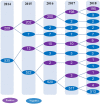Seroepidemiology of Chlamydia trachomatis Infection in the General Population of Northern China: The Jidong Community Cohort Study
- PMID: 34650533
- PMCID: PMC8507574
- DOI: 10.3389/fmicb.2021.729016
Seroepidemiology of Chlamydia trachomatis Infection in the General Population of Northern China: The Jidong Community Cohort Study
Abstract
A longitudinal serological study to investigate the seropositive frequency, incidence, and antibody dynamics of Chlamydia trachomatis infection in the general population of China is urgently needed in order to optimize the strategies for surveillance and precise prevention of C. trachomatis infection. This longitudinal study enrolled 744 subjects aged 18-65 years from Jidong Community of Northern China from 2014 to 2018. Seropositive frequency, incidence, and reinfection of C. trachomatis were determined by detecting antibody against C. trachomatis Pgp3 using "in-house" luciferase immunosorbent assay (LISA). The dynamic of anti-Pgp3 antibody was analyzed using the Generalized Estimating Equation (GEE) model. The overall Pgp3 seropositive frequency among the 18-65-year-old population was 28.1% (95% CI 24.9-31.5), and significantly increased from 12.0% in those aged 18-29 years to 48.6% in the 60-65 years old. The seropositive frequency was slightly higher in women than in men (31.3% vs. 25.4%) without statistical significance. The C. trachomatis incidence and reinfection rate were 11 and 14 per 1,000 person-years, respectively, and showed no significant difference with respect to age, gender, ethnicity, marital status, and education levels. Furthermore, anti-Pgp3 antibody remained detectable in 93.3% (195/209) of the seropositive subjects during the 5 years of follow-up. The overall decay rate for anti-Pgp3 antibody for CT-infected persons was -0.123 Log2 RLU/year, which was dramatically slower than in CT new infection (-3.34 Log2 RLU/year) or reinfection (-1.1 Log2 RLU/year). In conclusion, at least one quarter of the people aged 18-65 years have been infected with C. trachomatis over their lifetime while all age groups are susceptible to C. trachomatis infection in the community of Northern China. Therefore, comprehensive prevention strategies are urgently needed.
Keywords: Chlamydia trachomatis; anti-Pgp3 antibody; antibody decay; general population; incidence; seropositive frequency.
Copyright © 2021 Shui, Xie, Zhao, Ao, Lin, Liang, Wang, Dai and Tang.
Conflict of interest statement
The authors declare that the research was conducted in the absence of any commercial or financial relationships that could be construed as a potential conflict of interest.
Figures




Similar articles
-
The serodiagnositic value of Chlamydia trachomatis antigens in antibody detection using luciferase immunosorbent assay.Front Public Health. 2024 Feb 27;12:1333559. doi: 10.3389/fpubh.2024.1333559. eCollection 2024. Front Public Health. 2024. PMID: 38476494 Free PMC article.
-
Chlamydia trachomatis Pgp3 Antibody Persists and Correlates with Self-Reported Infection and Behavioural Risks in a Blinded Cohort Study.PLoS One. 2016 Mar 14;11(3):e0151497. doi: 10.1371/journal.pone.0151497. eCollection 2016. PLoS One. 2016. PMID: 26974653 Free PMC article.
-
Chlamydia trachomatis Pgp3 Antibody Population Seroprevalence before and during an Era of Widespread Opportunistic Chlamydia Screening in England (1994-2012).PLoS One. 2017 Jan 27;12(1):e0152810. doi: 10.1371/journal.pone.0152810. eCollection 2017. PLoS One. 2017. PMID: 28129328 Free PMC article.
-
Development and evaluation of an enzyme-linked immunosorbent assay for the detection of antibodies to a common urogenital derivative of Chlamydia trachomatis plasmid-encoded PGP3.J Immunol Methods. 2017 Jun;445:23-30. doi: 10.1016/j.jim.2017.03.002. Epub 2017 Mar 7. J Immunol Methods. 2017. PMID: 28283408
-
Developments in the screening for Chlamydia trachomatis: a review.Obstet Gynecol Clin North Am. 2003 Dec;30(4):637-58. doi: 10.1016/s0889-8545(03)00076-7. Obstet Gynecol Clin North Am. 2003. PMID: 14719842 Review.
Cited by
-
Active screening significantly improves detection of chlamydia in women's health clinics in Shaoxing, China.PLoS One. 2025 May 7;20(5):e0321492. doi: 10.1371/journal.pone.0321492. eCollection 2025. PLoS One. 2025. PMID: 40333999 Free PMC article.
-
Cross-sectional study on the seroprevalence, reinfection, and associated factors of Chlamydia trachomatis among female sex workers in Guangdong Province, China.BMC Infect Dis. 2025 Mar 13;25(1):354. doi: 10.1186/s12879-025-10650-x. BMC Infect Dis. 2025. PMID: 40082766 Free PMC article.
-
Chlamydia trachomatis Seroassays Used in Epidemiologic Research: A Narrative Review and Practical Considerations.J Infect Dis. 2024 Jul 25;230(1):250-262. doi: 10.1093/infdis/jiae199. J Infect Dis. 2024. PMID: 39052727 Free PMC article. Review.
-
The serodiagnositic value of Chlamydia trachomatis antigens in antibody detection using luciferase immunosorbent assay.Front Public Health. 2024 Feb 27;12:1333559. doi: 10.3389/fpubh.2024.1333559. eCollection 2024. Front Public Health. 2024. PMID: 38476494 Free PMC article.
-
Characterization of genital chlamydia trachomatis infection among women attending infertility and gynecology clinics in Hunan, China.BMC Infect Dis. 2024 Apr 15;24(1):405. doi: 10.1186/s12879-024-09254-8. BMC Infect Dis. 2024. PMID: 38622501 Free PMC article.
References
-
- Babinská I., Halánová M., Kalinová Z., Èechová L., Èisláková L., Madarasová Gecková A. (2017). Prevalence of Chlamydia trachomatis infection and its association with sexual behaviour and alcohol use in the population living in separated and segregated Roma settlements in Eastern Slovakia. Int. J. Environ. Res. Public Health 14:1579. 10.3390/ijerph14121579 - DOI - PMC - PubMed
LinkOut - more resources
Full Text Sources

